Sunrooms represent that magical transition between indoors and outdoors—a perfect sanctuary where natural light pours in while you remain protected from the elements.
These light-filled spaces have a unique ability to become the heart of any home, offering a retreat where you can bask in sunshine during winter months or enjoy a rainstorm without getting wet.
Architects and interior designers often describe sunrooms as the most versatile spaces in a home, functioning as reading nooks, dining areas, plant havens, or simply peaceful spots to start your day with a cup of coffee.
The popularity of sunrooms continues to grow as homeowners seek to create connections with nature while maintaining the comforts of indoor living.
Throughout different architectural periods, from Victorian conservatories to mid-century modern sunspaces, these light-filled rooms have evolved while maintaining their essential purpose of bringing warmth and natural light into homes.
✨Click to Get My 101 FREE Designer Room Ideas
Modern Minimalist Oasis
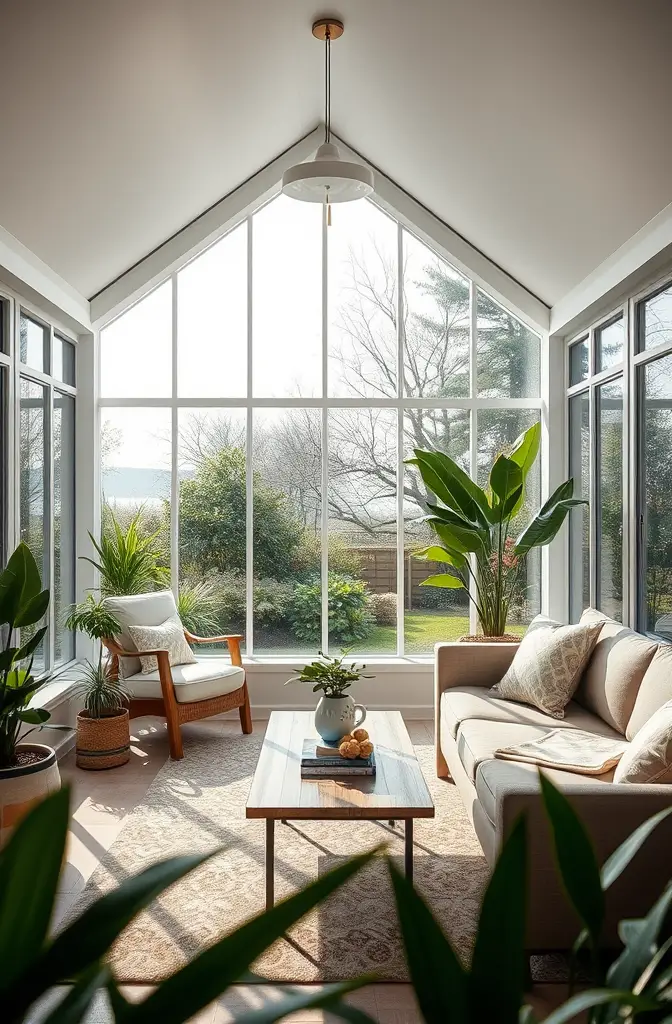
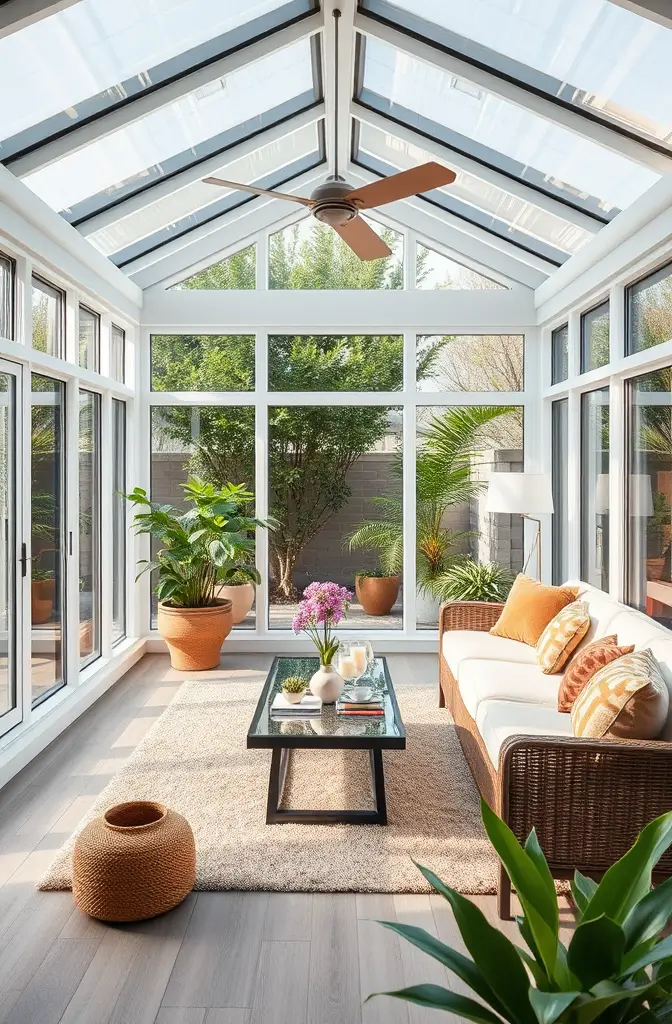
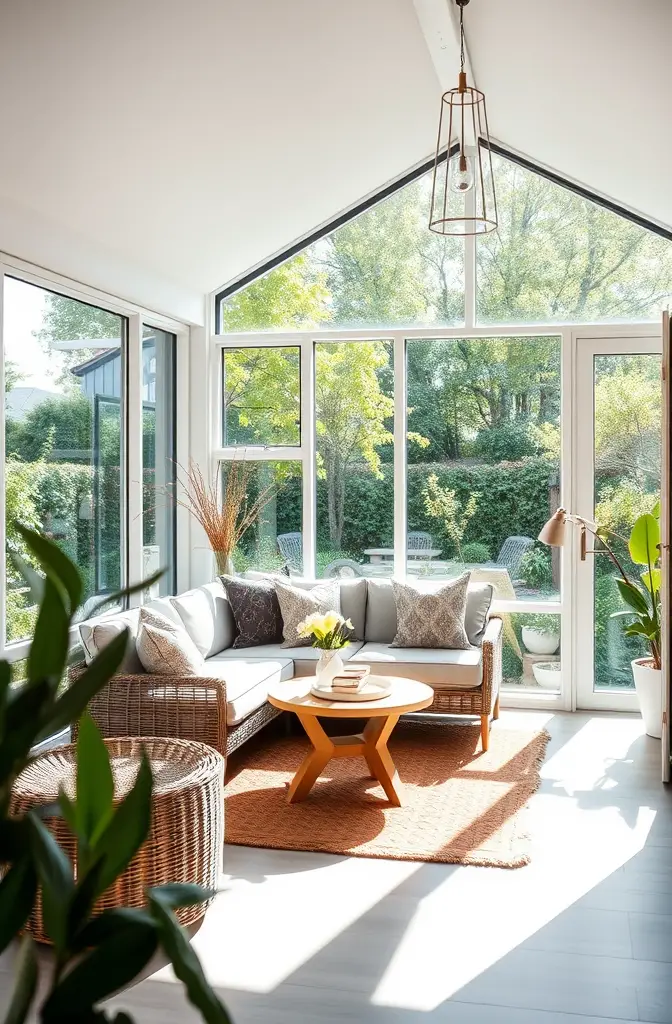
A modern minimalist sunroom design strips away the unnecessary to create a clean, peaceful retreat that still feels incredibly warm.
Think floor-to-ceiling windows with slim black frames that almost disappear into the view.
Choose low-profile furniture with simple lines in neutral tones like oatmeal, greige, or soft white.
Add warmth through natural materials – a jute rug, bamboo blinds, or a single stunning wooden accent piece can make all the difference.
Lighting should be unobtrusive – recessed ceiling fixtures or simple track lighting that doesn’t compete with natural sunlight.
For textiles, opt for high-quality natural fabrics with interesting textures rather than busy patterns.
Include just a few statement plants – perhaps a tall fiddle leaf fig in one corner and a trailing pothos on a high shelf.
The beauty of a minimalist sunroom is that it puts the focus on the changing natural light and the view outside your windows.
Temperature control becomes important in a glass-heavy space – consider cellular shades that can be tucked away during perfect weather but pulled down during extreme temperatures.
Add a simple ceiling fan with clean lines to keep air circulating without disrupting your minimalist aesthetic.
A built-in window seat with hidden storage helps maintain the clutter-free environment while providing a perfect reading nook.
For art, choose one oversized piece that complements the colors visible in your outdoor view rather than competing with it.
Avoid the temptation to add “just one more thing” – in minimalist design, negative space is actually a design element that creates calm.
Your flooring choice should be practical yet beautiful – large format porcelain tiles or engineered hardwood provide durability against sun exposure while maintaining clean lines.
Remember that minimalism doesn’t mean uncomfortable – include plush cushions and a soft throw, just keep them in your neutral palette.
Bohemian Jungle Retreat
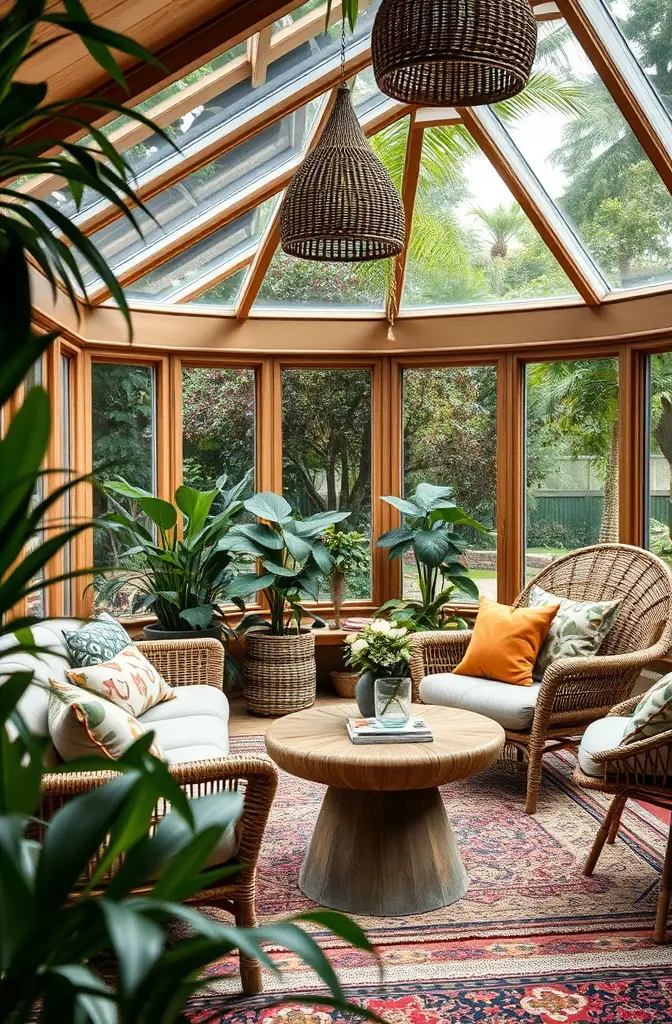
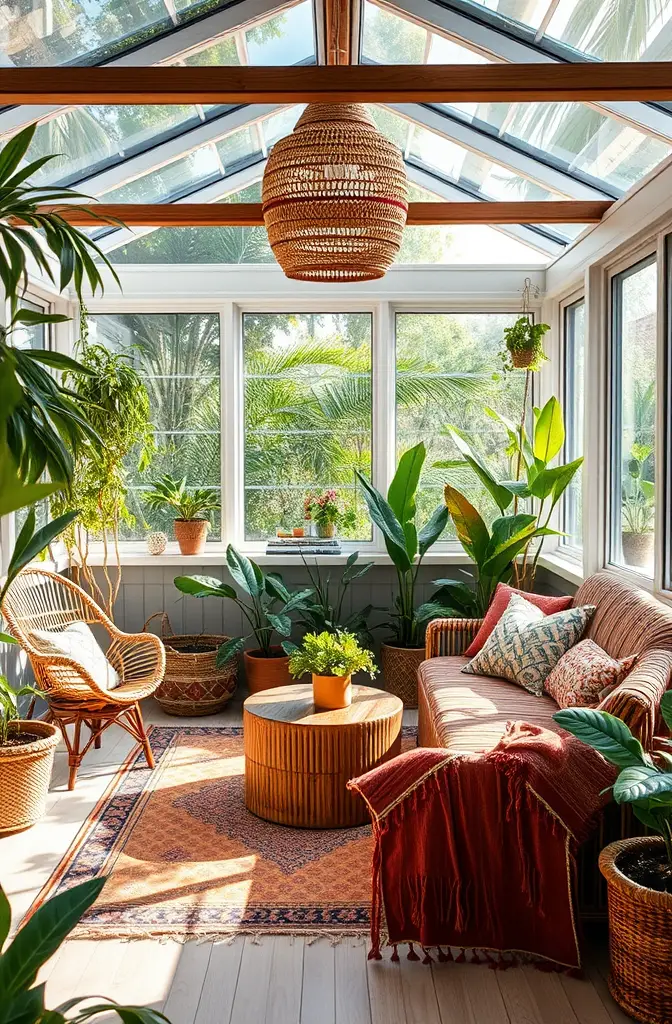
A bohemian sunroom transforms your space into a vibrant, plant-filled sanctuary that feels like you’ve stepped into a tropical paradise.
This style embraces an eclectic mix of colors, patterns, and textures that somehow work perfectly together.
Start with an abundance of plants – trailing vines, towering palms, exotic ferns, and flowering species that thrive in bright, indirect light.
Layer various textiles like Moroccan rugs, Indian block print throws, and embroidered pillows in rich jewel tones or earthy neutrals with pops of color.
Furniture should feel collected rather than purchased as a set – mix vintage rattan pieces with a plush velvet loveseat or daybed piled high with pillows.
Macramé plant hangers and wall hangings add texture and bohemian charm while making use of vertical space.
Lighting can include string lights, colorful paper lanterns, or brass and copper fixtures that cast warm, inviting glows after sunset.
Create cozy conversation areas with floor cushions arranged around a low coffee table made from reclaimed wood or a large brass tray.
Incorporate global elements like handmade pottery, baskets from various cultures, and artifacts that tell stories of travels (real or aspirational).
Window treatments should be light and airy – perhaps gauzy curtains that diffuse bright sunlight while still allowing it to filter through.
Add a hanging chair or hammock if space allows – these provide perfect spots for afternoon reading or napping in dappled sunlight.
The color palette can be earth-toned with terracotta, olive green, and ochre as your base, accented with vibrant blues, pinks, and oranges.
Wall treatments might include a feature wall with botanical wallpaper or a hand-painted mural that brings the outdoors inside.
Consider open shelving to display collected treasures, small plants, and colorful glassware that catches the light.
Music becomes part of the ambiance in this space – a vintage record player or bluetooth speaker disguised in a beautiful basket keeps good vibes flowing.
Don’t forget the importance of scent – natural incense, essential oil diffusers, or fresh flowers complete the sensory experience of your bohemian retreat.
Scandinavian Simplicity
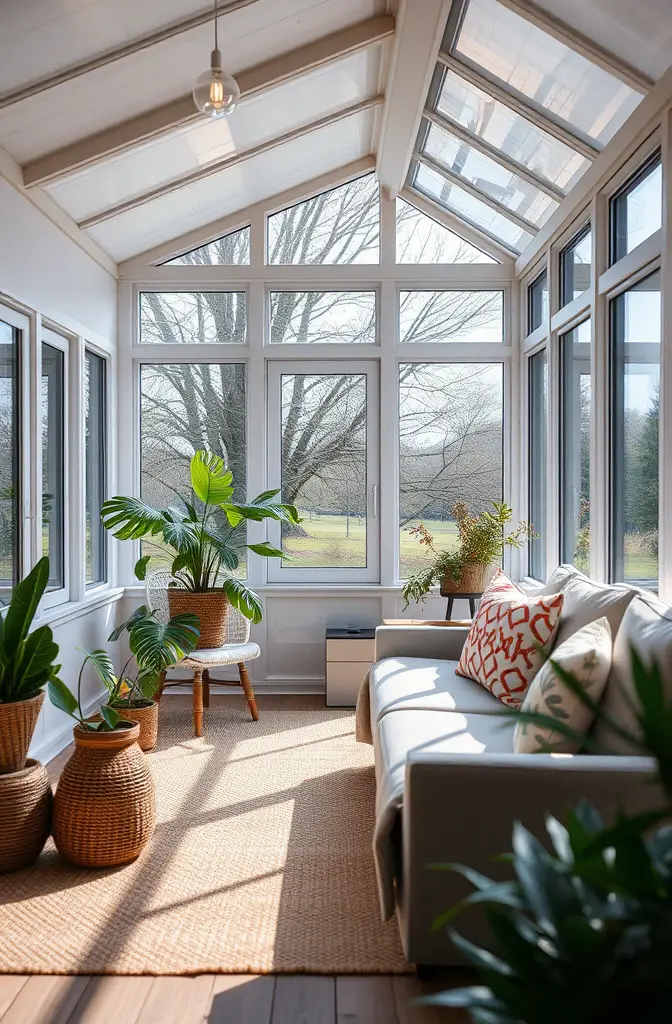
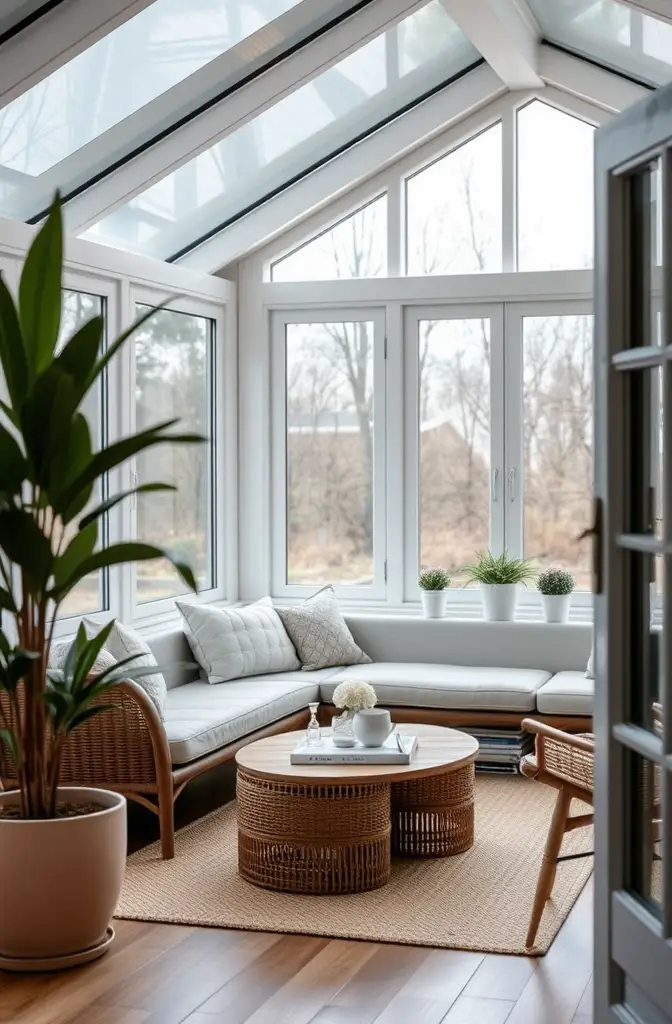
A Scandinavian-inspired sunroom embraces the “hygge” philosophy, creating a space that feels both bright and incredibly cozy at the same time.
White walls serve as the perfect backdrop, reflecting natural light throughout the room even on cloudy days.
Choose furniture with clean lines and light wood tones – birch, maple, or whitewashed oak all work beautifully in this aesthetic.
Layer in soft textiles like sheepskin throws, chunky knit blankets, and linen pillows in a palette of whites, grays, and subtle blues.
The floor might be light hardwood or large white tiles, perhaps with a simple area rug featuring a subtle geometric pattern.
Plants should be unfussy varieties with architectural qualities – succulents, snake plants, and eucalyptus branches in simple white ceramic pots.
Lighting needs to be warm and layered – pendant lights with natural materials like wood or rattan, combined with simple floor lamps and candles.
Create a reading nook with a comfortable chair, good task lighting, and a small side table – perfect for those long northern winters.
Storage solutions should be practical yet beautiful – think floating shelves, simple cabinets, or storage baskets in natural materials.
Window treatments remain minimal – perhaps simple roller blinds or sheer white curtains that filter light without blocking it.
Include elements that encourage relaxation – a small table for coffee or tea service, a bench with storage for games or books.
Artwork should be minimal and nature-inspired – perhaps black and white photographs of landscapes or simple line drawings in thin frames.
The beauty of Scandinavian design lies in its functionality – every item should serve a purpose while still being aesthetically pleasing.
Add warmth through natural materials like wool, cotton, jute, and unfinished woods rather than through busy patterns or bright colors.
Embrace negative space rather than filling every corner – the breathing room creates a sense of calm that’s central to this design philosophy.
Consider adding a small wood stove or electric fireplace for winter months when the sun’s warmth isn’t quite enough.
English Cottage Garden Room
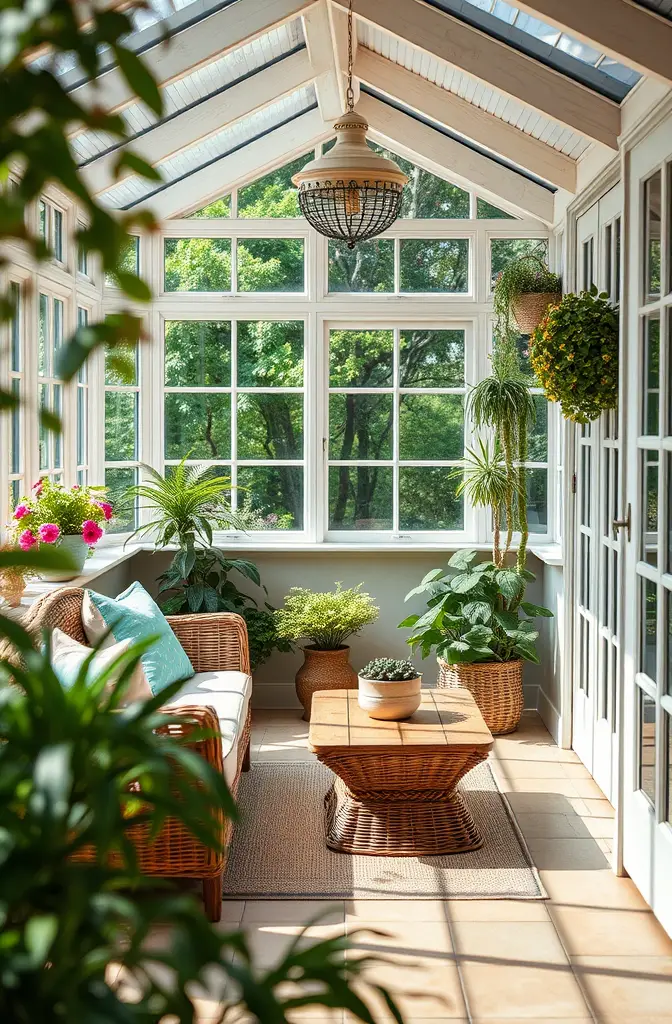
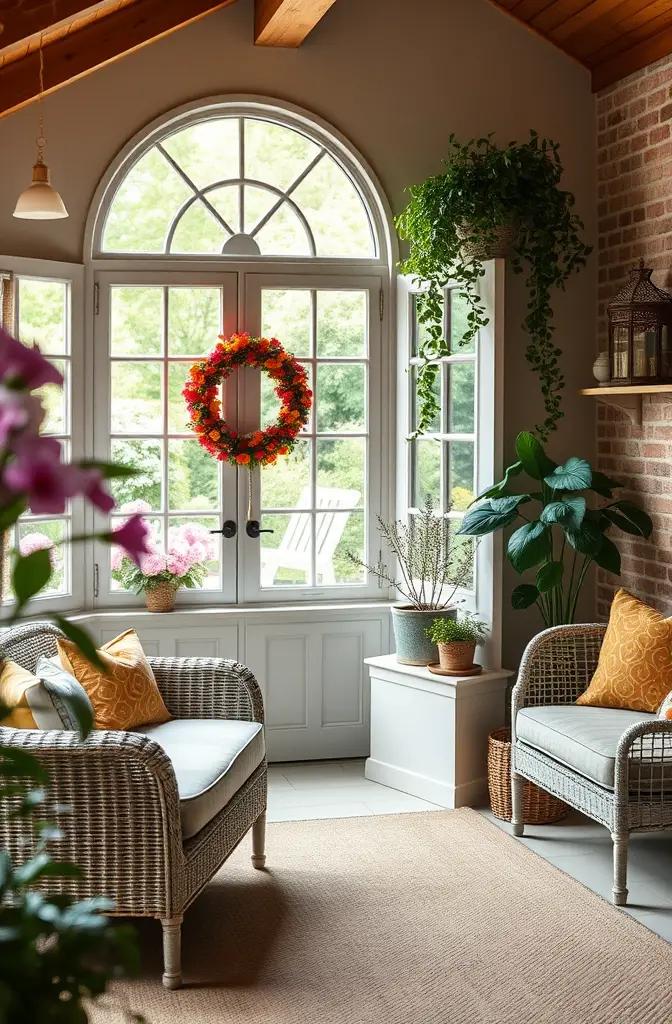
An English cottage garden sunroom brings the charm of the countryside inside with a design that feels both timeless and incredibly livable.
Floral patterns appear throughout – perhaps on cushions, curtains, or even a wallpapered accent wall featuring classic botanical prints.
Furniture should feel collected and comfortable – a mix of vintage and new pieces with curved lines and visible craftsmanship.
Incorporate plenty of wood tones through furniture, beams, or wainscoting to create warmth and architectural interest.
The color palette draws from an English garden – soft greens, lavenders, dusty blues, and rose pinks with creamy neutrals as a base.
Plants are absolutely essential – pots of herbs, flowering houseplants, and even small citrus trees in terracotta pots bring the garden feeling indoors.
Create a dining area with a round pedestal table and mismatched chairs painted in complementary colors for casual meals surrounded by greenery.
Display collections of vintage gardening books, botanical prints, or antique planters on open shelving or a weathered console table.
Window treatments might include cafe curtains or roman shades in subtle floral prints that filter light beautifully.
The flooring could be terracotta tiles, weathered wood, or stone – all materials that feel connected to gardens and traditional cottages.
Add architectural interest with salvaged elements like an old garden gate repurposed as wall decor or antique corbels used as bookends.
Lighting should feel warm and traditional – perhaps a small chandelier with a patina finish, complemented by table lamps with fabric shades.
Include storage that doubles as display – an antique hutch for dishes, a blanket chest that serves as a coffee table, or a potting bench for plants.
Create cozy nooks with cushioned window seats where you can watch the real garden outside while surrounded by your indoor version.
Consider vintage botanical or bird illustrations framed simply in wood or gold frames, grouped together for impact.
Weather-resistant wicker or rattan furniture pieces add authentic cottage style while standing up to the humidity of a plant-filled sunroom.
✨Click to Get My 101 FREE Designer Room Ideas
Mid-Century Modern Sunspace
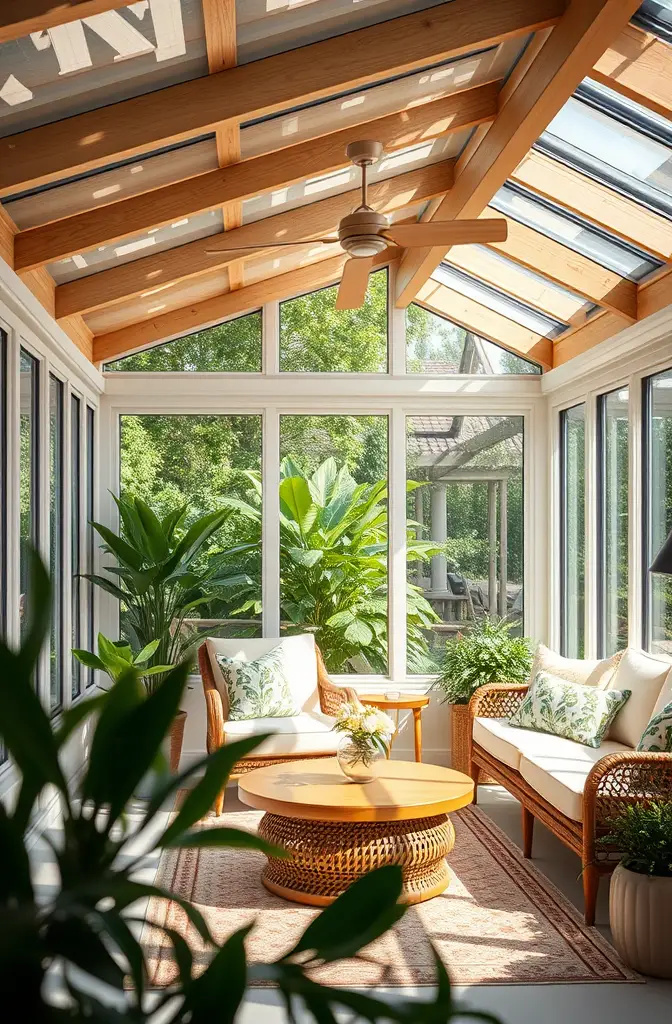
A mid-century modern sunroom captures the optimistic elegance of the 1950s and 60s while creating a space that feels fresh and current.
Clean lines, organic shapes, and a perfect balance between form and function define this timeless aesthetic.
Start with a statement piece – perhaps an iconic chair like the Eames lounge or a sculptural sofa in a rich color like mustard yellow, teal, or burnt orange.
The color palette balances warm and cool tones – think walnut wood against cool mint or crisp white walls with pops of bold color.
Large windows with minimal frames are ideal, often arranged in geometric patterns that become part of the design itself.
Flooring might be terrazzo, cork, or large format tiles – materials popular during the mid-century era that are experiencing a revival.
Plants play a key role – choose specimens with strong sculptural qualities like monstera, rubber plants, or palm varieties in simple pots.
Incorporate iconic lighting – a Sputnik chandelier, Arco floor lamp, or Nelson bubble pendant creates both illumination and artistic presence.
Furniture should be elevated off the floor on tapered legs, creating an airy feeling that’s perfect for a sunroom setting.
Add texture through woven elements like a Bertoia diamond chair or a simple sisal rug that won’t compete with your statement furniture.
A sleek credenza provides storage while displaying select decorative items – perhaps a collection of colorful vintage glass or ceramic pieces.
Window treatments should be minimal – consider wooden blinds or simple panel curtains that slide completely away during daylight hours.
Coffee and side tables might feature organic shapes with marble, glass, or wood tops supported by metal or wooden legs.
Incorporate a bar cart or built-in bar cabinet – a perfect mid-century touch for entertaining in your sunlit space.
Artwork should complement the era – abstract prints, atomic motifs, or Charley Harper-inspired nature illustrations work beautifully.
Don’t be afraid of pattern – geometric fabrics, starburst clocks, or a bold area rug can add energy to the space while still feeling period-appropriate.
Coastal Retreat Sunroom
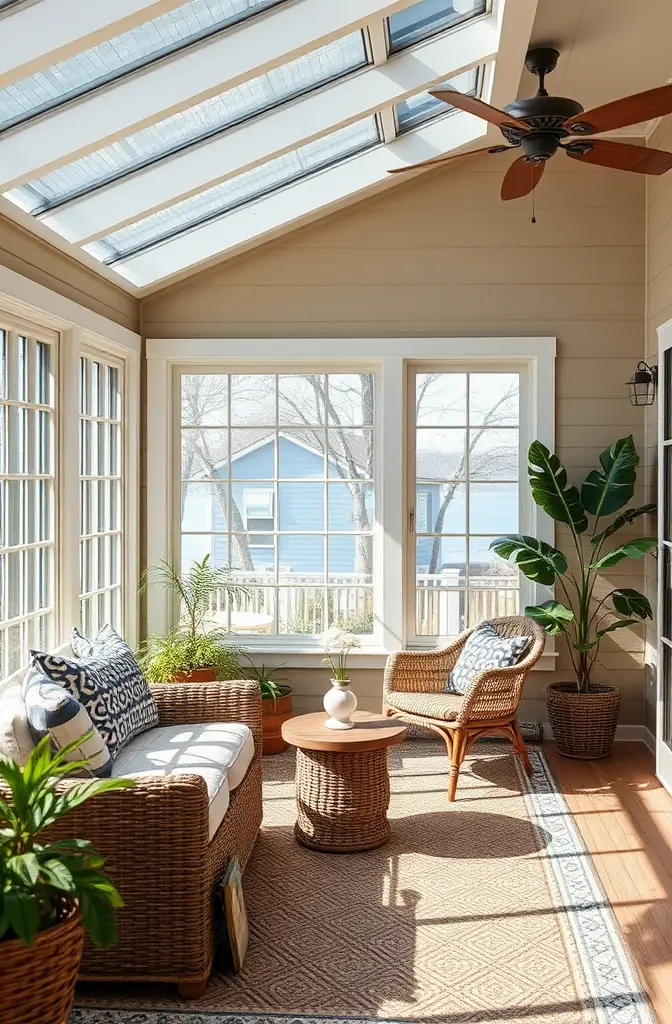
A coastal retreat sunroom brings the relaxed, breezy atmosphere of beach living into your home, no matter how far you are from the shore.
Natural light becomes your most important design element, so keep window treatments minimal with simple linen curtains or bamboo blinds that can be fully opened.
The color palette draws from sand, sea, and sky – soft whites, various blues from navy to aqua, and neutral beiges with perhaps a touch of coral or sea glass green.
Furniture should be comfortable and casual – slipcovered sofas and chairs in washable fabrics make perfect sense in a room that transitions between indoor and outdoor activities.
Natural fibers are essential – jute rugs, rattan or wicker furniture, and cotton or linen upholstery all support the coastal aesthetic.
Add nautical touches through accessories rather than theme-heavy decor – a driftwood lamp base, glass jars filled with shells, or a simple rope detail on a mirror.
Stripes appear throughout coastal design – consider a classic blue and white striped rug or cushions that recall beach umbrellas and cabanas.
Shiplap walls or ceiling treatments add architectural interest and authentic coastal character without overwhelming the space.
Lighting fixtures might incorporate natural elements like rope, driftwood, or capiz shells for a subtle beach reference.
Include plants that thrive in bright, indirect light and remind you of seaside landscapes – palms, succulents, and grasses work beautifully.
Create conversation areas that encourage relaxation – perhaps a pair of comfortable chairs facing the view rather than a television.
Weathered or whitewashed wood appears throughout – in furniture, frames, or architectural elements like beams or built-ins.
Incorporate open shelving to display curated collections of white ceramics, blue glassware, or natural elements gathered during beach trips.
Window seats or built-in banquettes maximize seating while providing storage for outdoor cushions, throws, or beach gear.
Outdoor fabrics have come a long way in terms of comfort and style – consider using these durable materials for upholstery in your sun-drenched space.
Add a ceiling fan with wooden blades reminiscent of boat propellers to keep air circulating while enhancing the coastal atmosphere.
Rustic Mountain Lodge Sunroom
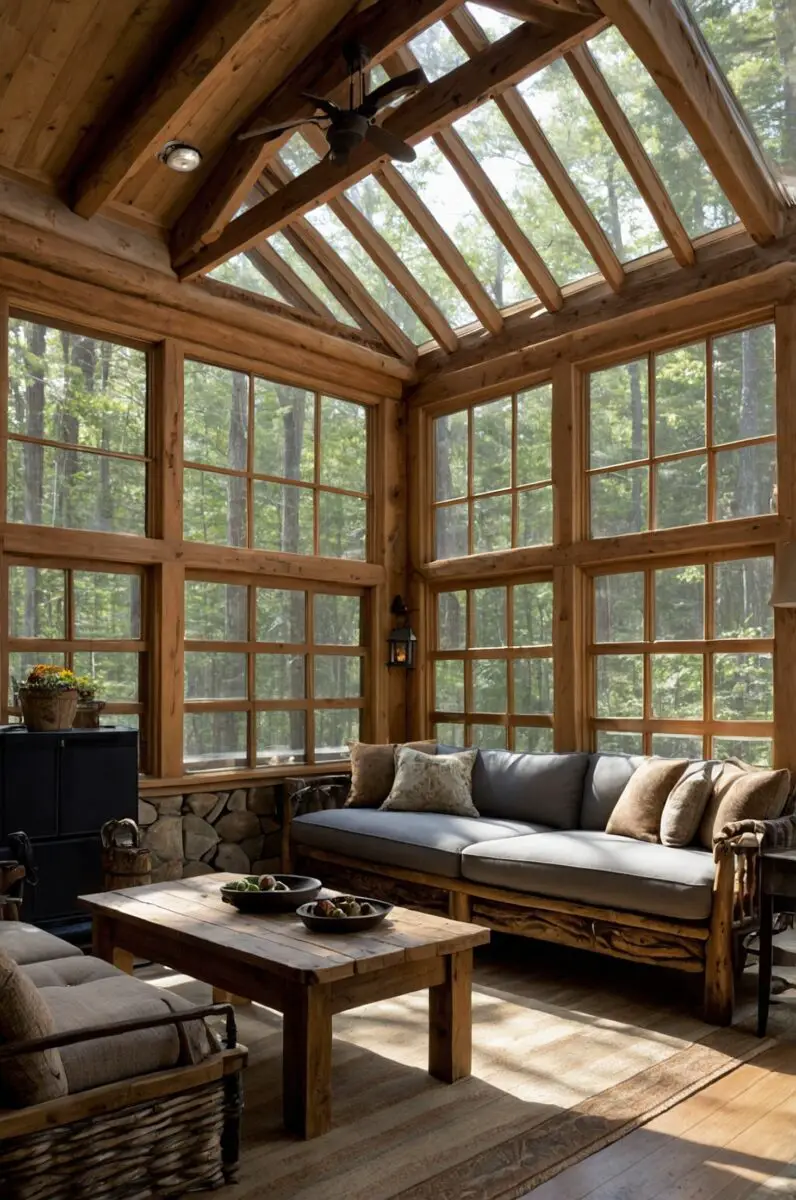
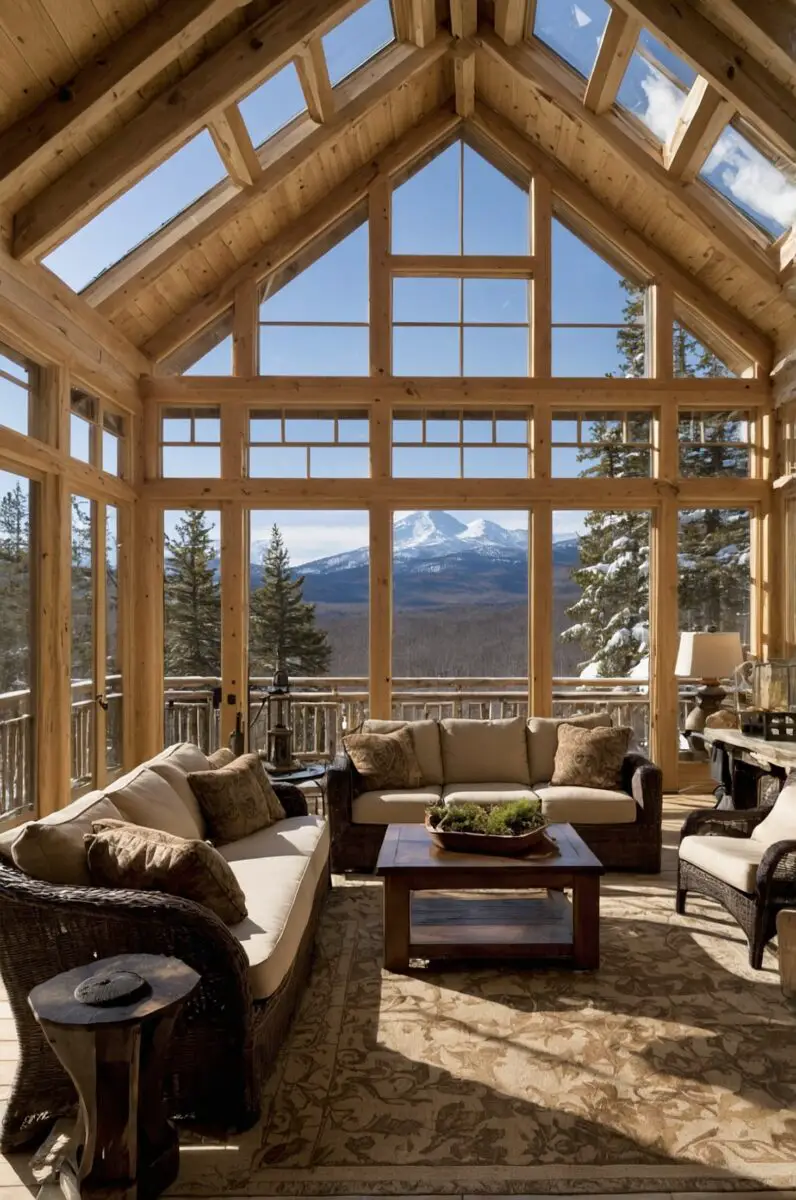
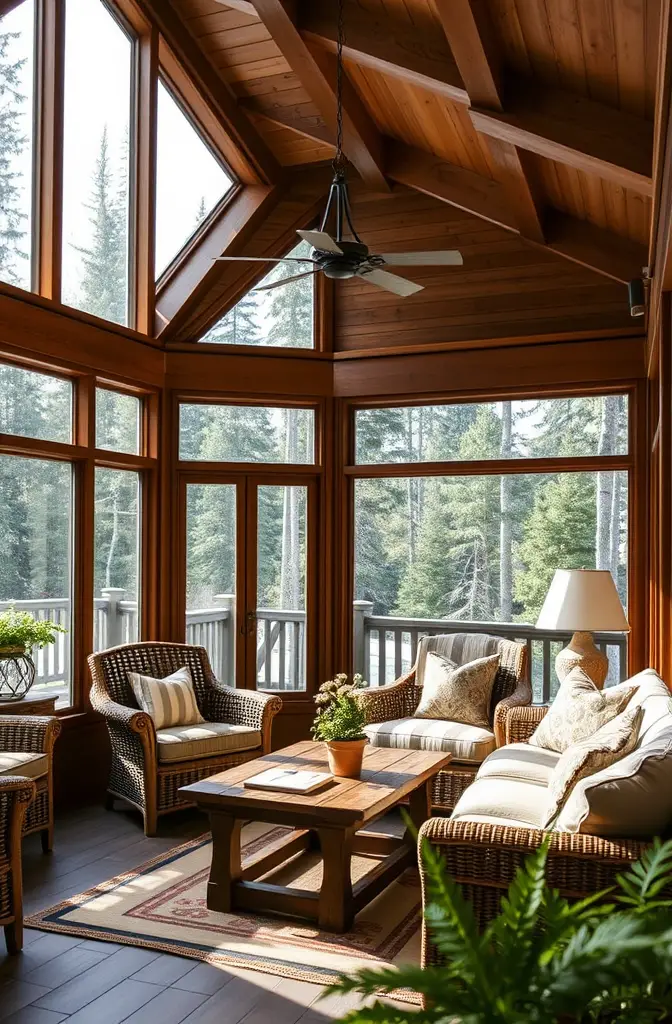
A rustic mountain lodge sunroom brings the cozy warmth of alpine retreats into your home, creating a space that feels connected to nature year-round.
Substantial wooden beams, whether structural or decorative, immediately establish the rustic character that defines this style.
Stone elements like a fireplace wall, flooring, or even just a few well-placed boulders as side tables add textural interest and authenticity.
The color palette draws from nature – deep greens, rich browns, burgundy, and mustard with black accents create a classic lodge feel.
Furniture should be substantial and comfortable – think oversized leather sofas, chunky wooden coffee tables, and perhaps a rocking chair or two.
Lighting needs to be layered – iron chandeliers or antler fixtures overhead, complemented by table lamps with substantial bases and simple shades.
Textiles play a crucial role – plaid woolens, Native American-inspired patterns, and faux fur throws create warmth and visual interest.
Create a focal point with a stone fireplace or wood stove where family and friends can gather on chilly evenings after outdoor adventures.
Window treatments should frame rather than hide your views – consider simple panels that can be pulled back completely or wooden blinds for privacy when needed.
Incorporate elements that tell stories – perhaps vintage snowshoes, antique fishing gear, or local landscape photography displayed on the walls.
Plants should be unfussy varieties that thrive in changing light conditions – ferns, succulents, and small evergreen specimens work well.
Add architectural interest with reclaimed wood on a feature wall or ceiling – the patina of aged timber adds character impossible to replicate with new materials.
Consider flooring that can handle traffic from outdoor activities – slate tiles, wide-plank hardwood, or concrete with area rugs all work beautifully.
Create distinct areas within the space – perhaps a reading nook with a chair and ottoman next to built-in bookshelves filled with favorites.
Storage becomes part of the design with blanket chests, vintage trunks as coffee tables, or built-in cabinets with iron hardware.
Don’t forget the importance of wildlife motifs – subtle references through artwork, cushions, or even drawer pulls add authentic lodge character.
Mediterranean-Inspired Solarium
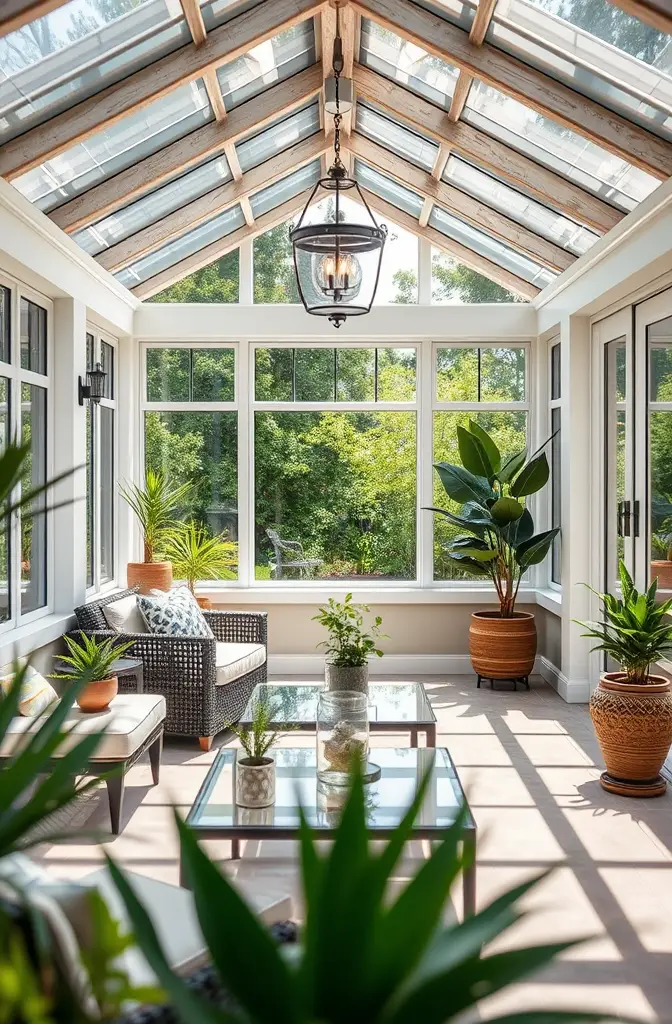
A Mediterranean-inspired solarium brings the sun-drenched warmth of coastal Italy, Greece, or Spain into your home with timeless elements that celebrate indoor-outdoor living.
Terracotta tiles in warm honey tones create the perfect foundation, reminiscent of sun-baked courtyards and ancient villas.
Whitewashed walls reflect light beautifully while providing a simple backdrop for architectural elements like arches or built-in niches.
The color palette pulls from Mediterranean landscapes – deep blues, terra cotta, olive green, and golden yellow appear as accents against neutral backgrounds.
Furniture should be comfortable yet elegant – perhaps wrought iron pieces with plush cushions or wooden tables with a weathered patina.
Incorporate classic Mediterranean elements like a small tiled fountain, mosaic details, or pots of lavender and citrus trees.
Textiles add color and pattern – look for fabrics featuring traditional motifs like Greek keys, Spanish tiles, or simple stripes in indigo and white.
Lighting fixtures might include wrought iron chandeliers, ceramic table lamps, or lantern-style sconces that cast beautiful patterns on walls after sunset.
Create an informal dining area where long, leisurely meals can be enjoyed surrounded by greenery – a rustic wooden table with mismatched chairs works perfectly.
Window treatments should be minimal but practical – perhaps simple linen curtains that can diffuse intense afternoon sun while still allowing light to filter through.
Add authenticity with handmade elements – ceramic vessels, woven baskets, or hand-painted tiles used as trivets or displayed on walls.
Plants play a crucial role – olive trees, bougainvillea, rosemary, and other Mediterranean varieties bring fragrance and color to the space.
Consider a ceiling treatment that adds interest – perhaps wooden beams, a simple plaster finish, or even a trellis element that creates dappled shadows.
Open shelving displays collections of blue and white ceramics, terracotta vessels, or colorful glassware that catches the light.
Create zones for different activities – a conversation area with comfortable seating, a small writing desk near a window, or a bistro table for morning coffee.
Add textural interest through natural materials like jute, rattan, terracotta, and stone – all elements common in Mediterranean interiors.
✨Click to Get My 101 FREE Designer Room Ideas
Japanese Zen Garden Room



A Japanese-inspired sunroom creates a tranquil sanctuary that celebrates simplicity, natural materials, and the changing seasons visible through your windows.
The design philosophy of “less is more” guides every choice, resulting in a space that feels both serene and deeply connected to nature.
Begin with a neutral color palette of whites, creams, and sandy beiges accented with black and perhaps a single muted color like moss green or slate blue.
Furniture should be low to the ground with clean lines – consider a platform daybed, floor cushions around a low table, or a simple bench beneath a window.
Natural materials are essential – bamboo blinds, paper lanterns, and elements of unfinished wood with visible grain all contribute to the authentic atmosphere.
Create a focal point with a small desktop water feature, a carefully arranged rock garden in a shallow container, or a single perfect bonsai tree.
Lighting should be soft and diffused – paper lanterns, bamboo pendants, or simple recessed lighting that doesn’t create harsh shadows.
Incorporate sliding panels or screens (inspired by traditional shoji screens) that can reconfigure the space or control light levels throughout the day.
Flooring might be tatami mats, bamboo, or simple wood planks – all materials that feel good underfoot and have natural warmth.
Add thoughtful storage solutions that maintain the clutter-free aesthetic – perhaps a tansu chest or simple floating shelves displaying just a few carefully chosen items.
Plants should have sculptural qualities – consider Japanese maples, cloud-pruned shrubs, or simple arrangements of river stones with moss.
Create a meditation corner with a comfortable cushion, a small side table for tea, and perhaps a view of your garden or a simple scroll on the wall.
Window treatments should be minimal – bamboo blinds or simple panels of natural fabric that filter rather than block light.
Incorporate one or two authentic Japanese elements like a traditional tea set, a calligraphy scroll, or a small arrangement of seasonal flowers (ikebana).
Pay attention to negative space – what you leave out is as important as what you include in creating authentic Japanese ambiance.
Consider adding a small rock garden or zen garden element that you can tend and rearrange, creating a meditative practice within your sunroom.
Industrial Loft Sunroom
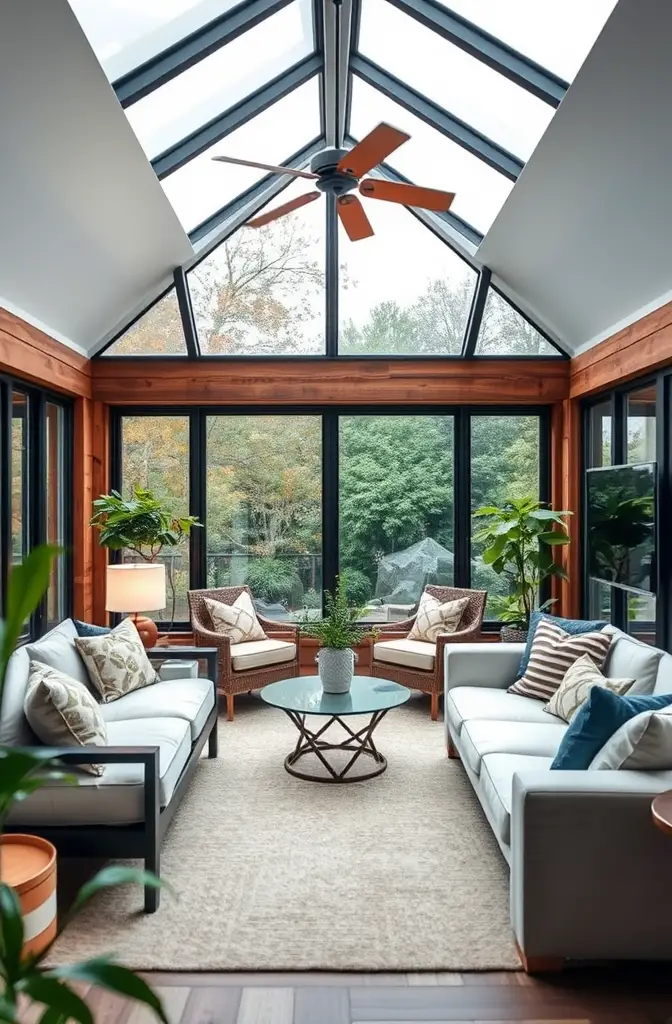
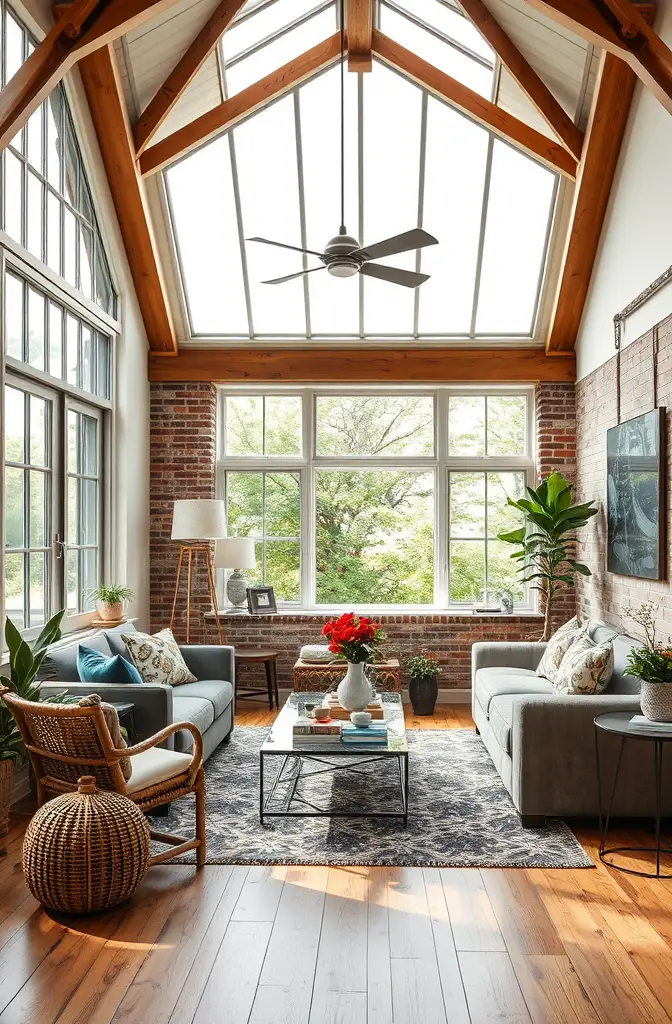
An industrial loft sunroom combines raw architectural elements with comfortable furnishings to create a space that feels both edgy and inviting.
Exposed brick, visible ductwork, or concrete floors immediately establish the industrial character that defines this style.
Large factory-style windows with metal frames provide both the essential sunlight and authentic industrial architecture.
The color palette tends toward neutrals – grays, blacks, and browns dominate, perhaps with strategic pops of color like deep teal or burnt orange.
Furniture should mix industrial materials with comfort – perhaps a leather sofa, metal-framed chairs with plush cushions, or repurposed factory pieces given new life.
Lighting fixtures become major design elements – vintage-inspired pendant lights with metal shades, Edison bulbs, or repurposed industrial fixtures make a statement.
Create contrast between hard and soft elements – balance metal and concrete with soft textiles, plants, and comfortable seating.
Incorporate salvaged architectural elements like old doors repurposed as tables, factory carts as coffee tables, or vintage signage as wall art.
Metal shelving units or pipe shelving provide both storage and display space while reinforcing the industrial aesthetic.
Plants add essential softness – large specimens in simple containers soften the hard edges and bring life to the space.
Add warmth through textiles – perhaps a vintage-inspired rug, leather poufs, or canvas cushions that reference workwear fabrics.
Consider a feature wall of reclaimed wood or metal panels that adds textural interest while honoring the industrial history that inspires the style.
Incorporate vintage industrial elements like old gauges, factory molds, or gears as decorative objects that tell a story.
Create zones within the open concept – perhaps a reading area with good task lighting and a comfortable chair near shelving for books.
Window treatments should be minimal and functional – consider roller blinds in canvas, simple metal blinds, or industrial-style shutters.
Don’t forget the importance of scale – industrial spaces typically have higher ceilings and larger proportions, so choose furniture and accessories accordingly.
French Country Conservatory

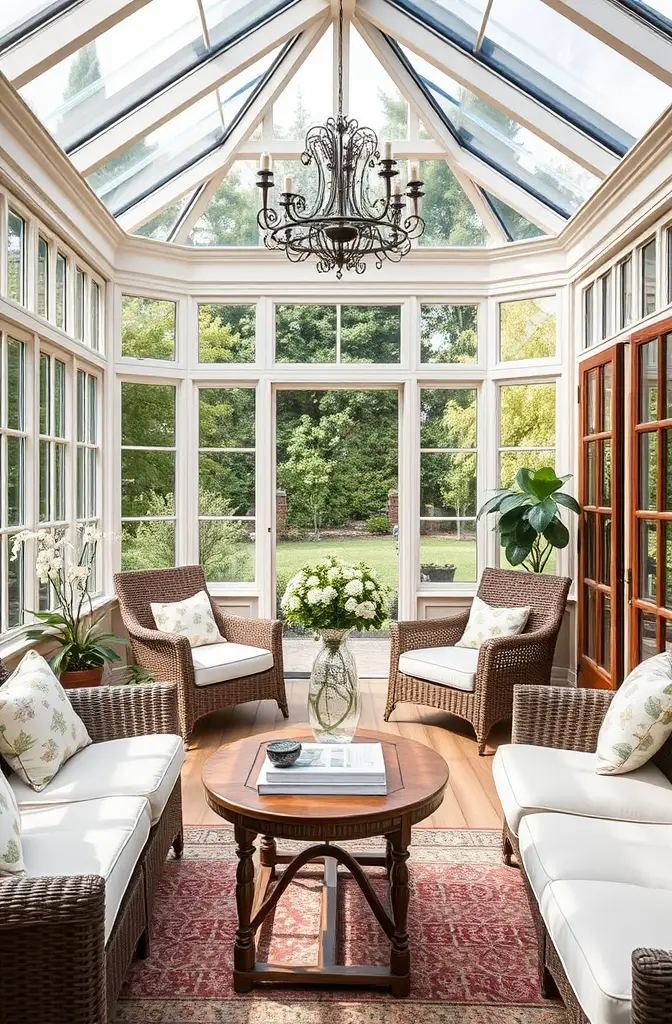
A French country conservatory brings the elegant comfort of Provence into your home with a perfect balance of refinement and rustic charm.
Weathered woods, painted furniture with subtle distressing, and natural stone elements create the foundation for this timeless aesthetic.
The color palette draws from the French countryside – lavender fields, sunflower yellows, and sky blues appear against backgrounds of creamy whites and soft grays.
Furniture should feel collected rather than purchased as sets – perhaps a painted armoire, a rustic farm table, and comfortable upholstered pieces with simple lines.
Patterns appear throughout – toile, subtle florals, stripes, and checks mix comfortably in this style when united by a common color scheme.
Incorporate authentic French elements like a zinc-topped table, copper cookware displayed on open shelving, or antique botanical prints in simple frames.
Plants are essential – lavender, rosemary, and topiaries in terracotta pots or zinc planters bring fragrance and reinforce the garden connection.
Lighting might include a simple iron chandelier, ceramic table lamps with linen shades, or wall sconces that provide warm, flattering light.
Create a dining area perfect for long, leisurely meals – a farm table with mismatched chairs works beautifully in this setting.
Window treatments remain simple and elegant – perhaps cafe curtains in linen or cotton, or Roman shades in a subtle pattern that filters light beautifully.
Add architectural interest with salvaged elements like old shutters used decoratively, a vintage mantel as a focal point, or corbels supporting simple shelving.
Textiles add comfort and character – linen slipcovers, cotton ticking stripes, and simple toile cushions create layers of interest.
The flooring might be limestone tiles, weathered wood planks, or terracotta – all materials with natural patina that improve with age.
Incorporate collections displayed simply – perhaps vintage pitchers, baskets, or blue and white ceramics grouped on open shelves.
Consider a potting bench or garden table where you can arrange flowers or tend to plants, reinforcing the indoor-outdoor connection.
Don’t forget the importance of vintage elements with patina – a bit of rust on garden implements or gentle wear on painted furniture adds authentic character.
Contemporary Greenhouse Sunroom

A contemporary greenhouse sunroom combines modern design principles with the traditional greenhouse structure to create a space that’s both cutting-edge and connected to nature.
Clean lines, minimal ornamentation, and a focus on the structure itself define this style – perhaps with black metal framing that creates dramatic geometric patterns.
The material palette features glass, metal, and concrete softened by natural elements like wood accents and abundant plantings.
Furniture should be sleek yet comfortable – weather-resistant pieces with clean lines work perfectly in this setting where the boundary between indoors and outdoors blurs.
The color scheme remains neutral – whites, blacks, and grays form the background with green from plants providing the main color element.
Lighting becomes architectural – perhaps track lighting that highlights specific plants or statement pendant lights that become sculptural elements after dark.
Create zones within the space – a conversation area with streamlined furniture, a dining section with a simple table and chairs, or a reading nook with good task lighting.
Plants become the stars of the show – choose specimens with architectural qualities like fiddle leaf figs, bird of paradise, or dramatic succulents.
Consider incorporating a living wall or vertical garden system that maximizes growing space while creating a stunning focal point.
Flooring should be practical yet beautiful – large format porcelain tiles, polished concrete, or composite decking all stand up to the moisture in a plant-filled environment.
Add warmth through textural elements like a simple wool rug, linen cushions, or a wooden bench that softens the harder elements of glass and metal.
Window treatments are typically minimal or absent – perhaps motorized shades that can be programmed to respond to light levels throughout the day.
Incorporate water features – a simple reflecting pool, a contemporary fountain, or a small circulating stream adds another natural element and pleasant ambient sound.
Consider built-in planters and seating that create a seamless look while maximizing your available space.
Add technology thoughtfully – perhaps automated irrigation systems, smart climate controls, or discrete speakers for music that doesn’t interrupt the clean aesthetic.
Don’t forget the practical elements – a sink for plant care, concealed storage for garden supplies, and easy-access water sources make maintaining your greenhouse sunroom much simpler.
✨Click to Get My 101 FREE Designer Room Ideas
Vintage Eclectic Sun Parlor

A vintage eclectic sun parlor celebrates personal history and collected treasures in a light-filled space that feels like it has evolved naturally over decades.
This style embraces a mix of periods and styles, united by your personal taste and the stories behind each piece.
Start with one or two anchor pieces with history – perhaps a Victorian fainting couch, an Art Deco side table, or a mid-century credenza that holds special meaning.
The color palette can be as vibrant or subdued as you prefer – this style works beautifully with jewel tones, pastels, or even a neutral backdrop punctuated with colorful accessories.
Incorporate vintage lighting that becomes a focal point – perhaps a crystal chandelier, colorful glass pendant lights, or brass floor lamps with character.
Textiles add warmth and personality – layered rugs, quilts passed down through generations, or cushions covered in fabrics collected during travels.
Display collections thoughtfully – vintage books, antique teacups, or travel souvenirs grouped by color or theme rather than scattered throughout the space.
Plants add life and connection to nature – consider varieties popular in different eras like ferns, spider plants, or Chinese money plants in collected vintage containers.
Create conversation areas that encourage interaction – perhaps chairs facing each other rather than a television, with a table between for games or tea.
Window treatments can add significant character – consider lace panels, vintage textile curtains, or blinds with decorative tape trim.
Add unexpected elements that reflect your personality – a birdcage repurposed as a plant holder, an old ladder used as shelving, or vintage suitcases stacked as a side table.
Incorporate art from various periods and styles – family photographs, landscapes, abstract pieces, and even children’s art can coexist beautifully when framed with intention.
The flooring might be original hardwood with a vintage rug, painted wooden boards, or even patterned tile that adds another layer of visual interest.
Create a space for your favorite activities – perhaps a writing desk near a window, a comfortable reading chair with good light, or a small table for puzzles or crafts.
Don’t forget the power of vintage accessories – old cameras, typewriters, record players, or radios add character even if they’re no longer functional.
Allow yourself the freedom to evolve the space over time – the most authentic eclectic rooms continue to grow with your experiences and discoveries rather than being designed all at once.


